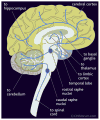PET tracers for serotonin receptors and their applications
- PMID: 25360773
- PMCID: PMC4330993
- DOI: 10.2174/1871524914666141030124316
PET tracers for serotonin receptors and their applications
Abstract
Serotonin receptors (5-HTRs) are implicated in the pathophysiology of a variety of neuropsychiatric and neurodegenerative disorders and are also targets for drug therapy. In the CNS, most of these receptors are expressed in high abundance in specific brain regions reflecting their role in brain functions. Quantifying binding to 5-HTRs in vivo may permit assessment of physiologic and pathologic conditions, and monitoring disease progression, evaluating treatment response, and for investigating new treatment modalities. Positron emission tomography (PET) molecular imaging has the sensitivity to quantify binding of 5-HTRs in CNS disorders and to measure drug occupancy as part of a process of new drug development. Although research on PET imaging of 5-HTRs have been performed more than two decades, the successful radiotracers so far developed for human studies are limited to 5-HT₁AR, 5-HT₁BR, 5-HT₂AR, 5-HT₄R and 5-HT₆R. Herein we review the development and application of radioligands for PET imaging of 5-HTRs in living brain.
Conflict of interest statement
The authors declare that there is no conflict of interest related to the content of the review.
Figures











References
-
- Rapport MM, Green AA, Page H. Serum vasoconstrictor, serotonin; isolation and characterization. J Biol Chem. 1948;176:1243–1251. - PubMed
-
- Nichols DE, Nichols CD. Serotonin receptors. Chem Rev. 2008;108:1614–1641. - PubMed
-
- Bush ES. Serotonin Receptors. Humana Press Inc; New Jersey: 2011.
-
- Tyce GM. Origin and metabolism of serotonin. J Cardiovas Pharm. 1990;16:S1–S7. - PubMed
-
- Glennon RA, Dukat M. Foye’s Medicinal Chemistry, Chapter 11. In: Williams DA, Zito SW, Lemke TL, Roche VF, editors. Serotonin Receptors and Drugs Affecting Serotonergic Neurotransmission. Lippincott, Williams, & Wilkins; Philadelphia: 2012.
Publication types
MeSH terms
Substances
Grants and funding
LinkOut - more resources
Full Text Sources

